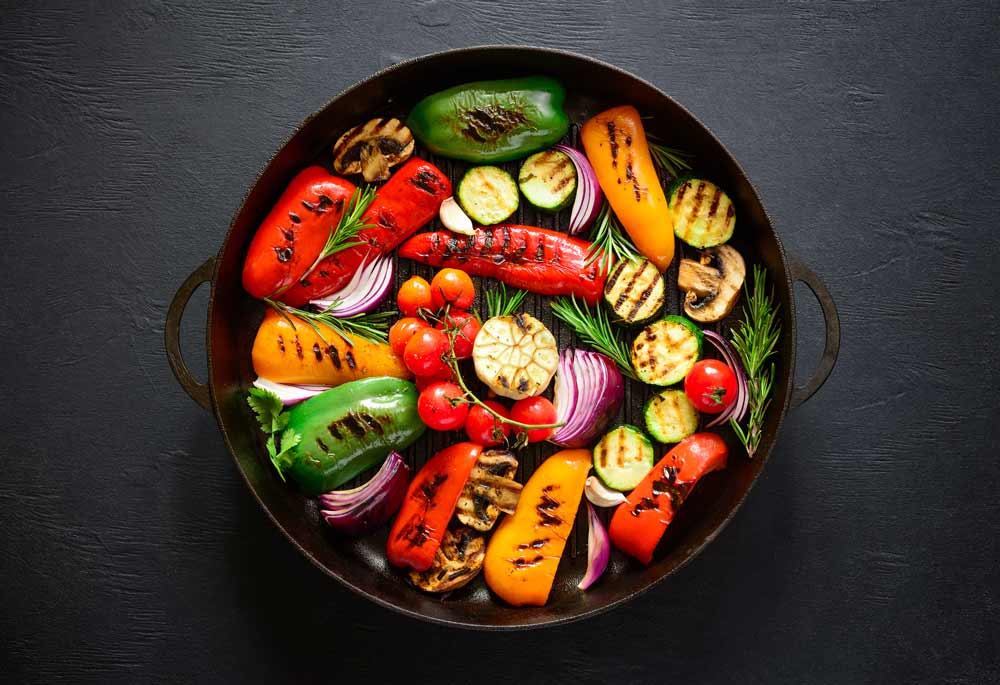¿POR QUÉ CAMBIARSE A UNA ALIMENTACIÓN BASADA EN PLANTAS?


Dr. William Flores Prado
Médico Cirujano, Acupunturista, experto en Nutrición
CMP 61628
PERÚ
POR NUESTRA SALUD
Sin duda, es la alimentación más sana que existe, y así ha sido demostrado en múltiples estudios (1,2). Previene y revierte enfermedades como hipertensión arterial (3), diabetes mellitus (4), ansiedad (5), depresión (6), enfermedades cardíacas (7), cerebrales (8), renales (9) y hepáticas (10), y otras enfermedades degenerativas (11).
POR LOS ANIMALES
Se estima que más de 150 mil millones de animales son asesinados cada año, la mayoría de ellos para comerlos o usar partes de sus cuerpos (más de 410 millones de animales cada día) a nivel mundial (12,13).
PARA VERNOS Y SENTIRNOS MEJOR
La alimentación basada en plantas nos hace más productivos (14), éticos (15) y empáticos (16), es la más sana y sostenible a largo plazo (17), y la que ha dado mejores resultados para perder peso (17) comparada con dietas bajas en carbohidratos (low-carb) (18).
COMO POSTURA POLÍTICA
La alimentación basada en plantas como postura política (19), es una forma de invocar igualdad (20), de fomentar los derechos de otros seres vivos e indefensos (21), de luchar contra la violencia (22), de no tratar a los animales como simples productos (23), y de disminuir el desperdicio de recursos (24).
POR NUESTRA AGUA
Para obtener calorías de alimentos animales se consume entre 5 a más de 12 veces la cantidad de agua (25) que se usa para alimentos vegetales (26,27). 1 kg de carne de res requiere más de 15,000 litros de agua, mientras las legumbres requieren 4,055 litros (25), y la soya requiere aún menos (28). Es decir, para producir menos de 0.5 kg de carne, usamos el equivalente a noventa duchas de 8 minutos (25).
POR NUESTRO AIRE
Según diversos estudios, el consumo de carne produce entre el 14.5% (29) hasta más del 18% de las emisiones globales de Gases de Efecto Invernadero (27). Es decir, más que toda la contaminación mundial por transporte (30,31). Los expertos indican que la diferencia podría ser mucho mayor (32). Por lo tanto, nuestra alimentación tiene gran impacto en el cambio climático (33,34).
POR NUESTROS BOSQUES
El abuso y la sobreexplotación de las tierras (35), los monocultivos de soya y maíz (36) con los que alimentan a los animales (37), tanto como la cría de ganado (38) per se, son las principales causas de la deforestación (27). Se utilizan las tierras para los monocultivos que, en gran parte, alimentan al ganado, lo mismo ocurre con las gigantescas granjas donde se cría ese ganado.
POR NUESTRA BIODIVERSIDAD
El 60% de la pérdida mundial de biodiversidad se debería a la crianza de animales (39). El cultivo de soya es uno de los principales causantes de la deforestación amazónica (40,27). Y, el 80% de la soya amazónica alimenta animales (41). Por ello, la clave para preservar la biodiversidad es reducir el consumo de animales (42).
CONTRA LA HAMBRUNA MUNDIAL
Se podría producir entre 2 a 20 veces mayor cantidad de comida similar, si reemplazáramos los alimentos de origen animal por fuentes de origen vegetal (43). Se ha comprobado que se podría incrementar la disponibilidad global de calorías por lo menos en 70% si usáramos todos los cultivos para consumo humano, en lugar de alimentar con ellos a los animales que luego consumimos (44).
POR EL PLANETA
En conclusión, con una alimentación basada en plantas disminuimos el daño al planeta (45,46), nos alimentamos de modo más ecológico y desperdiciamos menos recursos (47); así lograremos un planeta más equitativo y mejoraremos las condiciones de vida de las generaciones futuras.
Tengamos en cuenta que una alimentación sin productos de origen animal es probablemente la mejor forma de reducir nuestro impacto negativo en el planeta Tierra, incluso es más positivo que comprar un auto eléctrico (48).
Referencias
1. Appleby P. et al. (1999). The Oxford Vegetarian Study: an overview. The American Journal of Clinical Nutrition, 70(3 Suppl):525S-531S. doi: 10.1093/ajcn/70.3.525s
2. Fraser G. (1999). Associations between diet and cancer, ischemic heart disease, and all-cause mortality in non-Hispanic white California Seventh-day Adventists. The American Journal of Clinical Nutrition, 70(3 Suppl):532S-538S. doi: 10.1093/ajcn/70.3.532s
3. McDougall J. et al. (1995). Rapid reduction of serum cholesterol and blood pressure by a twelve-day, very low fat, strictly vegetarian diet. Journal of the American College of Nutrition, 14(5):491-6. doi:
10.1080/07315724.1995.10718541
4. Anderson J. & Ward K. (1979). High-carbohydrate, high-fiber diets for insulin-treated men with diabetes mellitus. The American Journal of Clinical Nutrition, 32(11):2312-21. doi: 10.1093/ajcn/32.11.2312
5. Beezhold B. & Johnston C. (2012). Restriction of meat, fish, and poultry in omnivores improves mood: a pilot randomized controlled trial. Nutrition Journal, 11:9. doi: 10.1186/1475-2891-11-9
6. Beezhold B. et al. (2010). Vegetarian diets are associated with healthy mood states: a cross-sectional study in seventh day adventist adults. Nutrition Journal, 9:26. doi: 10.1186/1475-2891-9-26
7. Esselstyn C. et al. (2014). A way to reverse CAD? Journal of Family Practice. 63(7):356-364b. Obtenido de: https://www.ncbi.nlm.nih.gov/pubmed/25198208
8. Casiglia E. et al. (2013). High dietary fiber intake prevents stroke at a population level. Clinical Nutrition, 32(5):811-8. doi: 10.1016/j.clnu.2012.11.025
9. Lin J. et al. (2010). Associations of diet with albuminuria and kidney function decline. Clinical Journal of the American Society of Nephrology, 5(5):836-43. doi: 10.2215/CJN.08001109
10. Kechagias S. et al. (2008). Fast-food-based hyper-alimentation can induce rapid and profound elevation of serum alanine aminotransferase in healthy subjects. Gut Journal, 57(5):649-54. doi: 10.1136/gut.2007.131797
11. Medina-Remón A. et al. (2018). Dietary patterns and the risk of obesity, type 2 diabetes mellitus, cardiovascular diseases, asthma, and neurodegenerative diseases. Critical Reviews in Food Science and Nutrition, 58(2):262-296. doi: 10.1080/10408398.2016.1158690
12. FAO (2018) Livestock Primary. Food and Agricultural Organization of the United Nations. Obtenido de: http://www.fao.org/faostat/en/#data/QL
13. FAO (2009). The State of World Fisheries and Aquaculture. Food and Agriculture Organization of the United Nations. Obtenido de: http://www.fao.org/docrep/011/i0250e/i0250e00.htm
14. Agarwal U. et al. (2015). A multicenter randomized controlled trial of a nutrition intervention program in a multiethnic adult population in the corporate setting reduces depression and anxiety and improves quality of life: the GEICO study. American Journal of Health Promotion,
29(4):245-54. doi: 10.4278/ajhp.130218-QUAN-72
15. Kessler C. et al. (2016). Personality Profiles, Values and Empathy: Differences between Lacto-Ovo-Vegetarians and Vegans. Forschende Komplementarmedizin, 23(2):95-102. doi: 10.1159/000445369
16. Filippi M. et al. (2010). The brain functional networks associated to human and animal suffering differ among omnivores, vegetarians and vegans. PloS One, 5(5):e10847. doi: 10.1371/journal.pone.0010847
17. Wright N. et al. (2017). The BROAD study: A randomized controlled trial using a whole food plant-based diet in the community for obesity, ischemic heart disease or diabetes. Nutrition & Diabetes, 7(3):e256. doi: 10.1038/nutd.2017.3
18. Fung T. et al. (2010). Low-carbohydrate diets and all-cause and cause-specific mortality: two cohort studies. Annals of Internal Medicine, 153(5):289-98. doi: 10.7326/0003-4819-153-5-201009070-00003
19. Deckers J. (2017). Why “Animal (De)liberation” survives early criticism and is pivotal to public health. Journal of Evaluation in Clinical Practice, 23(5): 1105–1112. doi: 10.1111/jep.12807 20. Lockwood R.. & Arkow P. (2016). Animal Abuse and Interpersonal Violence: The Cruelty Connection and Its Implications for Veterinary Pathology. Veterinary Pathology. Veterinary Pathology, 53(5):910-8. doi: 10.1177/0300985815626575
21. Bratanova B. et al. (2011). The effect of categorization as food on the perceived moral standing of animals. Appetite Journal, 57(1):193-6. doi: 10.1016/j.appet.2011.04.020
22. Kahane G. et al. (2018). Beyond Sacrificial Harm: A Two-Dimensional Model of Utilitarian Psychology. Psychological Review, 125(2): 131–164. doi: 10.1037/rev0000093
23. Cole M. (2011). From “Animal Machines” to “Happy Meat”? Foucault's Ideas of Disciplinary and Pastoral Power Applied to ‘Animal-Centred’ Welfare Discourse. Animals Journal, 1(1): 83–101. doi: 10.3390/ani1010083
24. Campbell T. (2017). Nutritional Renaissance and Public Health Policy. Journal of Nutritional Biology, 3(1): 124–138. doi: 10.18314/jnb.v3i1.145
25. Mekonnen M. & Hoekstra A. (2010). The water footprint of farm animals and animal products. UNESCO-IHE. Obtenido de: http://waterfootprint.org/en/water-footprint/product-water-footprint/water-footprint-crop-and-animal-products/
26. Mekonnen M. & Hoekstra A. (2012). A Global Assessment of the Water Footprint of Farm Animal Products. Ecosystems, 15(3):401–415. doi: 10.1007/s10021-011-9517-8
27. FAO (2006). Livestock's Long Shadow: Environmental Issues and Options. Food and Agriculture Organization of the United Nations. Obtenido de: http://www.fao.org/docrep/010/a0701e/a0701e00.HTM
28. Ercin A. et al. (2012). The water footprint of soy milk and soy burger and equivalent animal products. Ecological Indicators, 18: 392-402 doi: 10.1016/j.ecolind.2011.12.009
29. Rojas-Downing M. et al. (2017). Climate change and livestock: Impacts, adaptation, and mitigation. Climate Risk Management, 16: 145-163. doi: 10.1016/j.crm.2017.02.001
30. FAO (2013). Tackling Climate Change Through Livestock: Key Findings. Food and Agriculture Organization of the United Nations. Obtenido de: http://www.fao.org/news/story/en/item/197623/icode/
31. EPA (2017). Global Greenhouse Gas Emissions Data. United States Environmental Protection Agency. Obtenido de: https://www.epa.gov/ghgemissions/global-greenhouse-gas-emissions-data
32. Goodland R. & Anhang J. (2009). Livestock and Climate Change: What if the key actors in climate change are cows, pigs, and chickens? World Watch. Obtenido de: http://www.worldwatch.org/files/pdf/Livestock and Climate Change.pdf
33. Harwatt H. (2018). Impact Report of the Humane Society of the United States’ “Meatless Monday” Campaign. HSUS. Obtenido de: https://www.dropbox.com/s/586g537dy0hexhl/Impact analysis for MM 2012 - 2017.pdf?dl=0
34. Stehfest E. et al. (2009). Climate benefits of changing diet. Climatic Change, 95(1-2):83-102. doi: 10.1007/s10584-008-9534-6
35. Le Tourneau F. (2016). Is Brazil now in control of deforestation in the Amazon? Cybergeo: European Journal of Geography. doi: 10.4000/cybergeo.27484
36. Nole S. (2018). The Road. The Globe and Mail. Obtenido de https://www.theglobeandmail.com/news/world/amazon-rainforest-deforestation-crisis/article37722932/
37. Fearnside P. (2017). Business as Usual: A Resurgence of Deforestation in the Brazilian Amazon. Yale Environment 360. Obtenido de: https://e360.yale.edu/features/business-as-usual-a-resurgence-of-deforestation-in-the-brazilian-amazon
38. FAO. Cattle Ranching and Deforestation. FAO Livestock Information. Obtenido de: http://www.fao.org/3/a-a0262e.pdf
39. WWF (2017). Appetite for Destruction. WWF: Do it for the Planet. Obtenido de: https://www.wwf.org.uk/sites/default/files/2017-11/WWF_AppetiteForDestruction_Full_Report_Web_0.pdf
40. Gomez S. Paraguay: Soy and Farming are Destroying Biodiversity. Latin American Post. Obtenido de: https://latinamericanpost.com/index.php/analysis-global/17732-paraguay-soy-and-farming-are-destroying-biodiversity
41. Yale School of Forestry & Environmental Studies. Soy Agriculture in the Amazon Basin. Global Forest Atlas. Obtenido de: https://globalforestatlas.yale.edu/amazon/land-use/soy
42. Machovina B. et al. (2015). Biodiversity conservation: The key is reducing meat consumption. The Science of the Total Environment, 536:419-431. doi: 10.1016/j.scitotenv.2015.07.022
43. Shepon A. et al. (2018). The opportunity cost of animal-based diets exceeds all food losses. Proceedings of the National academy of Sciences of the United States of America. doi: 10.1073/pnas.1713820115
44. Cassidy E. et al. (2013). Redefining agricultural yields: from tonnes to people nourished per hectare. Environmental Research Letters 8(3). Obtenido de: http://iopscience.iop.org/article/10.1088/1748-9326/8/3/034015
45. Meyer N. & Reguant-Closa A. (2017). “Eat as If You Could Save the Planet and Win!” Sustainability Integration into Nutrition for Exercise and Sport. Nutrients, 9(4): 412. doi: 10.3390/nu9040412
46. Tilman D. & Clark M. (2014). Global diets link environmental sustainability and human health. Nature, 515(7528):518-22. doi: 10.1038/nature13959
47. Hamerschlag K. & Venkat K. (2011). Meat Eater’s Guide to Climate Change + Health. Environmental Working Group. Obtenido de: http://static.ewg.org/reports/2011/meateaters/pdf/methodology_ewg_meat_eaters_guide_to_health_and_climate_2011.pdf
48. Poore J. & Nemecek T. (2018). Reducing food’s environmental impacts through producers and consumers. Science, 360(6392):987-992. doi: 10.1126/science.aaq0216
Dr. William Flores
CMP 61628
Médico Cirujano, Acupunturista, experto en Nutrición
Facebook: Dr. William Flores
Instagram: drwilliamflores
Website: drwilliamflores.com
Youtube: Dr. William Flores
Bien de Salud Wellness Center
Teléfonos: 225 2326 – 281 8677
